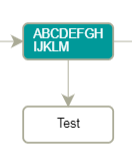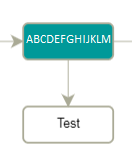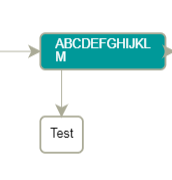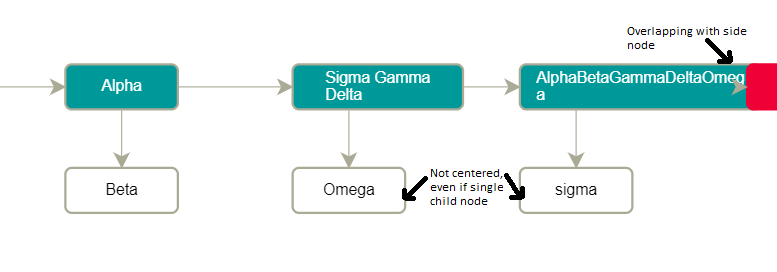Hi,
In my diagram, I have the parent level nodes to which child nodes are linked through straight arrows.
Using the covering tree layout I am able to set parent node width to the size of the subtree
For straight orthogonal lines to the center of the child node are set using a custom class - Barlink
<!DOCTYPE html>
<html>
<head>
<title>Minimal GoJS Sample</title>
<!-- Copyright 1998-2022 by Northwoods Software Corporation. -->
</head>
<body>
<div id="myDiagramDiv" style="border: solid 1px black; width:100%; height:600px"></div>
<script src="https://unpkg.com/gojs"></script>
<script id="code">
// This custom Link class is smart about computing the link point and direction
class BarLink extends go.Link {
getLinkPoint(node, port, spot, from, ortho, othernode, otherport) {
const r = port.getDocumentBounds();
const op = otherport.getDocumentBounds();
const below = op.centerY > r.centerY;
const y = below ? r.bottom : r.top;
if (op.right < r.left) return new go.Point(r.left, y);
if (op.left > r.right) return new go.Point(r.right, y);
return new go.Point((Math.max(r.left, op.left) + Math.min(r.right, op.right))/2, y);
}
getLinkDirection(node, port, linkpoint, spot, from, ortho, othernode, otherport) {
const p = port.getDocumentPoint(go.Spot.Center);
const op = otherport.getDocumentPoint(go.Spot.Center);
const below = op.y > p.y;
return below ? 90 : 270;
}
}
// end BarLink class
const $ = go.GraphObject.make;
const myDiagram =
$(go.Diagram, "myDiagramDiv",
{
layout:
$(go.TreeLayout,
{
angle: 90,
setsPortSpot: false,
setsChildPortSpot: false,
arrangement: go.TreeLayout.ArrangementHorizontal
}),
"undoManager.isEnabled": true
});
myDiagram.nodeTemplate =
$(go.Node, "Auto",
$(go.Shape,
{ fill: "white" },
new go.Binding("fill", "color")),
$(go.TextBlock,
{ margin: 8, editable: true },
new go.Binding("text").makeTwoWay())
);
myDiagram.linkTemplate =
$(BarLink,
{ routing: go.Link.Orthogonal },
$(go.Shape),
$(go.Shape, { toArrow: "Standard" })
);
myDiagram.linkTemplateMap.add("Seq",
$(go.Link,
{ isLayoutPositioned: false, isTreeLink: false },
$(go.Shape),
$(go.Shape, { toArrow: "OpenTriangle" })
));
myDiagram.model = new go.GraphLinksModel(
[
{ key: 0, text: "Start" },
{ key: 1, text: "Alpha", color: "lightblue" },
{ key: 2, text: "Beta", color: "orange" },
{ key: 3, text: "Gamma", color: "lightgreen" },
{ key: 4, text: "Delta", color: "pink" },
{ key: 11, text: "Alpha1", color: "lightblue" },
{ key: 12, text: "Beta1", color: "orange" },
{ key: 13, text: "Gamma1", color: "lightgreen" },
{ key: 21, text: "Alpha2", color: "lightblue" },
{ key: 22, text: "Beta2", color: "orange" },
{ key: 23, text: "Gamma2", color: "lightgreen" },
{ key: 24, text: "Delta3", color: "pink" },
{ key: 25, text: "Epsilon3", color: "yellow" },
{ key: 31, text: "Alpha3", color: "lightblue" },
{ key: 32, text: "Beta3", color: "orange" },
{ key: 33, text: "Gamma3", color: "lightgreen" },
{ key: 99, text: "End" }
],
[
{ from: 0, to: 1, category: "Seq" },
{ from: 1, to: 2 },
{ from: 1, to: 3 },
{ from: 3, to: 4 },
{ from: 1, to: 11, category: "Seq" },
{ from: 11, to: 12 },
{ from: 11, to: 13 },
{ from: 11, to: 21, category: "Seq" },
{ from: 21, to: 22 },
{ from: 21, to: 23 },
{ from: 22, to: 24 },
{ from: 24, to: 25 },
{ from: 21, to: 31, category: "Seq" },
{ from: 31, to: 32 },
{ from: 31, to: 33 },
{ from: 31, to: 99, category: "Seq" }
]);
</script>
</body>
</html>
As shown
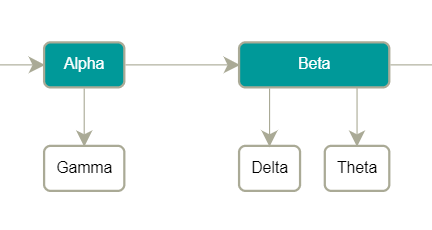
But in some cases where the parent node text length is longer, it wraps the text as so -
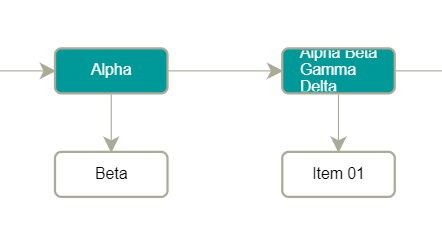
to avoid it - as you mentioned I tried to set the node width by comparing actual bounds to subtree width, but by doing so, the wrap text issue is not resolved. In addition the link alignment is improper -
Hope this helps
Thanks
